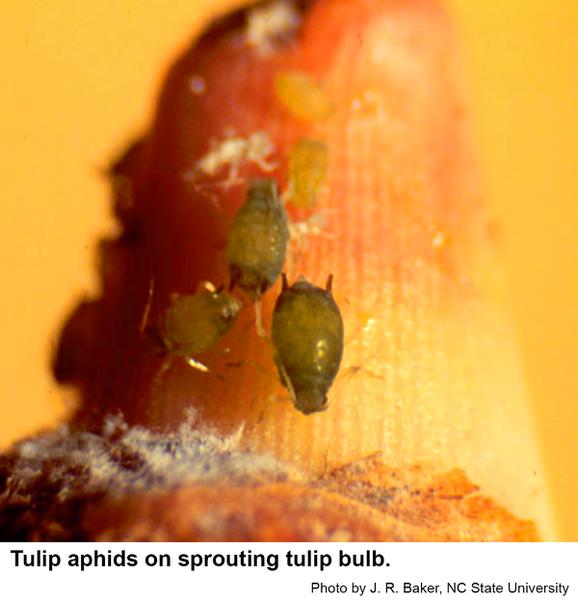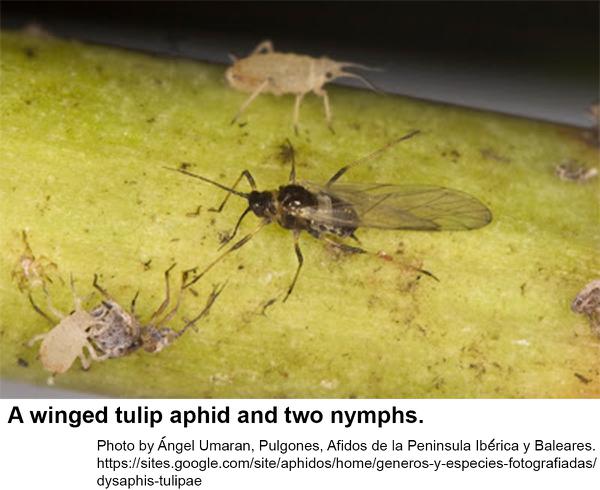Description and Biology
Tulip aphids, Dysaphis tulipae, are small, typical, pale to dark green aphids with moderately long, dark cornicles. They are sometimes called tulip bulb aphids because they feed on tulip bulbs and other ornamental plant bulbs in storage as well as in the field. It is also called the iris root aphid. When infested bulbs are planted, the new growth may be distorted and stunted. Tulip aphids also infest the leaves, shoots, buds and flowers of these plants after they are growing. This aphid can transmit tulip breaking virus to tulips and narcissus yellows streak virus to narcissus in the landscape (the latter by non-persistent transmission so there must be an infested plant nearby for the virus to be spread successfully). It has been shown to transmit other plant viruses as well. Not much has been published on the life history of the tulip aphid. For much of the year, they give birth to live nymphs that gradually mature into wingless or winged adults.
Host Plants
Tulip aphids attack Chionodoxa (glory of the snow), crocus, gladiolus corms, iris bulbs, lily, narcissus, scilla, snowdrop, and tulip during storage. Later they are found at the bases of growing plants, and under the leaf sheaths of all kinds of garden irises. It also occurs on the roots of carrot, parsley, and celery.
Residential Recommendations
Immersing infested bulbs in a solution of insecticidal soap should give adequate control. On growing ornamentals use insecticidal soap, one of the pyrethroids labeled for landscape use, or a systemic insecticide such as imidacloprid. When used as directed, pyrethroids are very toxic to insects but are not particularly hazardous to humans and pets (other than fish-avoid using pyrethroids around pools, ponds, and streams).
References
- Aphids Feeding on Celery in California. Essig, E. O. 1938. Hilgardia 11 (9): 459-492.
- Aphids on Ornamental Landscape Plants. Steven Frank. 2009. Entomology Insect Notes, NC State Extension Publications.
- Field Transmission of Tulip Breaking Virus and Serologically Relate Potyviruses in Tulip. Hammond, J. 1989. Plant Disease 73: 331-336.
- Insect and Related Pests of Flowers and Foliage Plants. Baker, J. R. ed. 1994 (revised). North Carolina Cooperative Extension Service publication AG-136.
- Extension Plant Pathology Publications and Factsheets
- Horticultural Science Publications
- North Carolina Agricultural Chemicals Manual
For assistance with a specific problem, contact your local Cooperative Extension Center.
This Factsheet has not been peer reviewed.
Publication date: Jan. 9, 2017
Reviewed/Revised: Oct. 17, 2019
Recommendations for the use of agricultural chemicals are included in this publication as a convenience to the reader. The use of brand names and any mention or listing of commercial products or services in this publication does not imply endorsement by NC State University or N.C. A&T State University nor discrimination against similar products or services not mentioned. Individuals who use agricultural chemicals are responsible for ensuring that the intended use complies with current regulations and conforms to the product label. Be sure to obtain current information about usage regulations and examine a current product label before applying any chemical. For assistance, contact your local N.C. Cooperative Extension county center.
N.C. Cooperative Extension prohibits discrimination and harassment regardless of age, color, disability, family and marital status, gender identity, national origin, political beliefs, race, religion, sex (including pregnancy), sexual orientation and veteran status.


